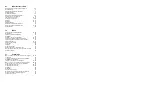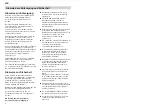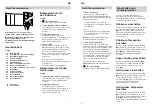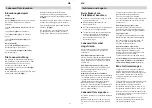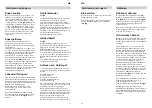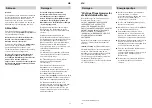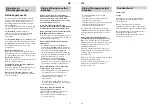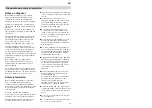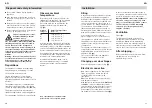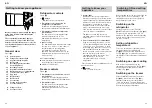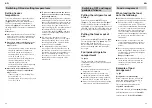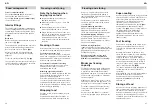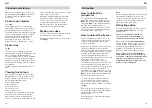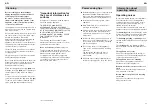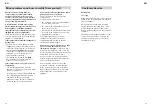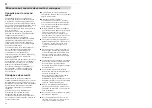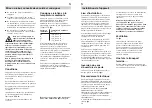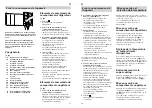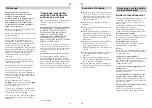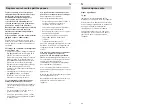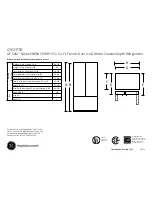
29
en
28
en
Observe that food should not project over
the stacking limit (Figure
C
/A) otherwise air
circulation within the appliance will be
obstructed.
Frozen food calendar
Figure
8
It is important not to exceed maximum
permissible storage times in order to avoid
impairing the quality of the frozen goods.
The actual storage time depends on the type
of food. The numbers next to the symbols
indicate the permissible storage time in
months. In the case of frozen goods
purchased from a shop, observe the
production date or ‘Best before …’ date.
Freezer tray
Fig.
A
The freezer tray is suitable for storing ice
cube trays and for freezing individual berries,
pieces of fruit, herbs and vegetables.
To freeze individual items of food, distribute
the produce uniformly on the freezer tray
and leave to freeze for approx. 10–12 hours.
Then transfer the produce into freezer bags
or containers.
To thaw, spread out the individual items of
food.
Thawing frozen food
Depending on the nature of the food and
the preparation or cooking method you are
going to employ, you may choose one of
the following thawing methods:
at room temperature,
in the refrigerator,
in an electric oven,
fan-assisted or not,
in the microwave oven.
Food that has been partially or completely
defrosted can be refrozen provided that
these items are stored at temperatures
below +3 °C and for no longer than one day
Freezing and storing
where meat and fish is involved, or no longer
than 3 days for other items.
Otherwise, provided that taste, smell and
appearance remain unchanged, you can
boil, fry or process the food further into
a ready-made dish and then refreeze.
Observe that in this case the admissible
shelf-life will be shorter than normal.
Making ice-cubes
Fill the ice-cube tray three-quarters full with
water and place it in the freezer.
Twist the tray slightly to remove the ice-cubes
(Figure
=
).
Defrosting
How to defrost the
refrigerator
The refrigerator defrosts automatically.
Defrosting water collects in a gutter, (Fig.
9
/B) before flowing through the drainage
outlet, (Fig.
9
/A) to the evaporating tray at
the back of the appliance where it
evaporates. Make sure that there is never
any blockage in defrosting water flow (see
instructions under “Cleaning”).
How to defrost the freezer
Large accumulations of frost or ice on the
freezer grids have an adverse effect on the
efficiency of the appliance and increase
energy consumption.
When the frost is approx. 1/2 cm thick, the
freezer should be defrosted. It should,
however, be defrosted at least once or twice
a year, preferably when the freezer is totally
or nearly empty. Remember to switch on
fast-freezing approximately four hours
before defrosting if you still have food stored
in the freezer. This will cause the
temperature of the food to drop to an
extremely low degree and ensure that it can
be kept safely at room temperature for a
longer period. Then remove the drawers with
their contents, wrap in several layers of
newspaper or a blanket and store in a cool
place. Press the ON/OFF freezer switch (Fig.
2
/9) to switch off the freezer compartment.
Then leave the freezer door open.
To collect the defrosting water, leave the
second frozen food container empty in
place. Use a sponge to remove the thaw
water from the bottom surface of the freezer
(Fig.
E
).
Defrost as quickly as possible (the longer
the products are kept at room temperature,
the shorter their shelf-life will be
subsequently).
Clean the interior of the freezer thoroughly
after defrosting.
Note
We recommend putting the frozen foods into
the refrigerator during the defrost of the
freezer. Please ensure that the frozen foods
should not come into contact with foods
which are already in the fridge.
Defrosting advice
To speed up defrosting, it is best to place a
saucepan with hot water
on one of the
freezer grids.
Under no circumstances should an
electric heater, a petroleum lamb or
candles be used to defrost the freezer.
Caution when using
defrosting sprays
as
these may form explosive gases or else
contain solvents or propellants which can
damage the plastic fittings inside the
appliance. They can also be a potential
hazard to your health or cause corrosion.
Never scrape off ice or frost with any
sharp metal objects as this can damage
the surface of the freezer grids which will
then rust. If any pipework is pierced,
refrigerating spurting out may cause eye
injuries or else it may ignite.

